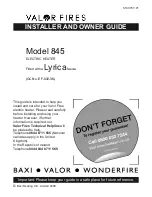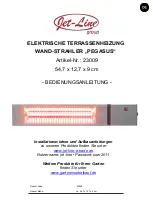
23
SYSTEM INSTALLATION
GENERAL
If the system is to be filled with water for testing or other purposes
during cold weather and before actual operation, care must be taken to
prevent a downdraft entering the boiler or freezing air from contacting the
system. Failure to do so may cause the water in the system to freeze
with resulting damage to the system. DAMAGE DUE TO FREEZING IS
NOT COVERED BY THE WARRANTY.
Good practice requires that all heavy piping, etc., be supported.
Figure 13 shows a typical primary, secondary piping method. This is
the preferred piping method for most copper fin tube boilers. Other
piping methods, however, may provide good system operation. A prime
concern when designing heating systems is the maintenance of proper
flow through the unit during boiler operation. The secondary pump should
be sized per the recommended flow rate of the boiler, see Dimension
and Capacity Data in this manual.
A bypass line must be installed, as shown in Figure 13, to prevent boiler
circulation starvation when the system zones call for reduced flow.
This bypass may also be used with multiple boilers manifolded for
reverse-return flow. This system bypass would be installed from boiler
outlet to suction side of pump.
HOT WATER HEATING (HYDRONIC) SYSTEM
The following is a brief description of the equipment required for
the installations noted in this manual. All installations must comply
with local code.
1. WATER SUPPLY LINE
These boilers can be used ONLY in a forced circulation hot water
heating system. Since most forced circulation systems will be of
the closed type, install the water supply line as shown on piping
diagram, see Figure 13.
Fast filling of large pipe, old radiator installations and pressure
purging of series loop systems (where high pressures are not
available) requires bypassing of the pressure reducing valve.
Gener ally, pressure purging is not possible with a well pump
system. High point air venting is essential.
If the system is of the open type, a pressure reducing valve will not
be required as the water supply to the system will be controlled by
a manu ally operated valve. An overhead surge tank is required. A
minimum pressure of 15 psi (100kPa) must be maintained on the
boiler at all times to ensure avoidance of potential damage to the
boiler which may not be covered by the warranty.
2. EXPANSION TANK
If the system is of the closed type, install an expansion tank
as shown in Figure 13. The sizing of the expansion tank for
a closed system is very important and is directly related to
the total water volume of the system. Refer to “Systems
and Equipment” volume of the ASHRAE handbook.
An air separator as shown in the piping diagrams
is recom mended especially for modern commercial
hydronic systems.
3. VENT VALVES
It is recommended that automatic, loose key or screw-driver
type vent valves be installed at each convector or radiator.
4. SYSTEM HEADERS
Split systems with individual supply and return lines from
the boiler room should normally have this piping connected
to supply and return manifold headers near the boiler. To
achieve good water distribution with maximum pressure
drop for sever al circuits, manifolds should be larger than
system mains.
The circuits should be spaced on the heater at a minimum
of 3” (76mm) center to center. Install a balancing cock
in each return line.
Manifold headers are recommended for split systems with
or without zone valves and also those installations with zone
circulators. If the system is to be split at remote points, good
practice requires special attention be given to main pipe sizing
to allow balancing of water flow.
5. CHECK VALVES
Check valves must be installed to isolate each boiler in
installations where multiple boilers/pumps are installed
in the same zone.
6. COOLING PIPING
When the boiler is used in conjunction with a refrigeration
system it must be installed so that the chilled medium is
piped in parallel with the boiler. Appropriate flow control
valves, manual or motorized, must be provided to prevent
the chilled medium from entering the boiler.
Water temperature in the heating system must be reduced
to less than 100°F (38°C) before cooling system is started,
or damage to the chiller unit may occur.
If the boiler is connected to chilled water piping or its heating
coils are exposed to refrigerated air, the boiler piping system
must be equipped with flow valves or other automatic means
to prevent gravity circulation through the boiler during the
cooling cycle.
Primary/secondary pumping of both the chiller(s) and the
boiler(s) is an excellent winter-summer change-over method,
because cooling flow rates are so much more than heating
flow rates. In this way each system (heating or cooling) is
circulated independently.
7. CIRCULATING PUMP
HOT WATER HEATING BOILERS - VB MODELS
, the
factory supplied pump is optional, Field installed pump must
not exceed 1 hp.
NOTE: If a system pump is to be installed on a VB
model, the maximum rating of the pump motor must not
exceed 1 hp.
















































